The Chicken Story Retold
The basic premise of the human rights theory is that human beings have certain rights and that means the state has some obligations to ensure that people enjoy these rights. This includes basic rights such as the right to life, liberty, speech, expression, religion, participation in decision-making, equality, education, health, and housing. However, some conditions prevent some people from exercising these rights or enjoying them. For example, female infants are still killed in many parts of the country although the Constitution gives the right to equality to all women. Colored people are still discriminated against in many parts of the world. At the root of these unfair, contrived social attitudes are patriarchal and racist mindsets.
Speciesism is the equivalent to patriarchy and racial segregation and was first used in the 1970s to describe the discrimination practiced against nonhuman animals. For example, speciesist attitudes prevent us from perceiving the chicken to have the basic right to life. Chickens stuffed in small cages outside butcher shops seen in the lanes and bylanes of the country does not move many of us. While selecting a living chicken outside a butcher shop to be cut up into a meal, our thoughts do not dwell on what the chicken may be thinking at that moment; whether the bird’s marble-like, glassy eyes are “seeing” us at all; what the cries, hysterical flapping of the wings indicate as the bird is pulled out from the cage held by the neck; and so on. We even fail to note that the chicken did not walk to her death in eagerness to become our meal – we did not note the blatant coercion in the act. Our sense to empathize with the chicken is completely shut as we have never been indoctrinated to perceive the chicken as a sentient being with unique mannerisms. Chickens lay eggs for us and give us meat, is all that we know about the chicken. In this sense, the chicken is our property, a commodity whose flesh and eggs we can buy with money and so, we have the right to use the bird as we please.
Some of us intuitively sense the wrongness and unethical nature of the act as part of a blessed process of aligning our energies with the benevolent Universal consciousness – that vast, formless reservoir of energy where each living being in this Universe is drawing sustenance from – with every draw and release of our breaths. This breath connects every living being to one another and in this sense, there is a part of each one of us within the chicken and a part of the chicken within us. This sense of interconnected consciousness bestows upon us the “awareness” that a chicken is not our property and exploiting a chicken for eggs and meat is an infringement over the chicken’s right to life and safety. However, some of us need evidence. It is fair that we educate ourselves about chicken sentience if we believe that the chicken is not a conscious being but rather a non-living entity like a chair or a table and so we are justified in objectifying them.
In the main part of this story, we will try and gain a fresh perspective of looking at the chicken with the help of studies done on the chicken under the evolving field of trans-species psychology. This field of psychology holds that nonhuman animals are mentally and emotionally comparable to humans in terms of their cognitive capacities and emotions; therefore it submits that animal cognition and emotions should be studied using the same models created to study human beings. Trans-species psychology employs scientific data collected from the fields of biology, physiology, neuroscience, ethology, and psychology; subjective data collected with the help of observations; and affective data collected through empathetic anthropomorphism to arrive at conclusions about animal cognition and emotions. Scientists working in this field have gathered evidence for all that we believed animals are incapable of such as the ability to feel pain, suffer bereavement, possess memory, display social behavior, empathize, form bonds, and so on.
According to the United Poultry Concerns (UPC) website, in a paper published in Nature Neuroscience Reviews in 2005, the Avian Brain Nomenclature Consortium which is an international group of scientists, presented the overwhelming evidence that a bird’s brain is a highly complex organ of which fully 75 percent “is an intricately wired mass that processes information in much the same way as the vaunted human cerebral cortex”. In light of this evidence, the Consortium called upon scientists around the world to adopt a new language to describe the various parts of the bird’s brain. This decree has led to many remarkable studies in avian intelligence. We must inform our readers at this point that a lot of the research cited in this story has been inspired by the extraordinary website, United Poultry Concerns, which contains a mine of information based on studies in trans-species psychology about our magnificent, fellow Earthlings – The Chicken.
Did we know that chickens could show sophisticated social behavior and were capable of complex reasoning comparable to that of a human child? Perhaps we did not; however, research has brought forth interesting data. According to Dr. Chris Evans, Professor of Psychology at Macquarie University, Australia:
“Chickens exist in stable social groups. They can recognize each other by their facial features. They have 24 distinct cries that communicate a wealth of information to one other, including separate alarm calls depending on whether a predator is traveling by land or sea. They are good at solving problems. As a trick at conferences, I sometimes list these attributes, without mentioning chickens, and people think I’m talking about monkeys. Perhaps most persuasive is the chicken’s intriguing ability to understand that an object, when taken away and hidden, nevertheless continues to exist. This is beyond the capacity of small children.” (source)
Some among the 24 distinct cries are documented in this article entitled, Chicken Talk by Dr. Karen Davis, animal rights advocate, author, and President of UPC.
Dr. Lesley J. Rogers, avian specialist and Professor of Neuroscience and Animal Behaviour, University of New England, Australia in her book, The Development of Brain and Behaviour in the Chicken, writes that the chicken has:
“….a complex nervous system designed to form a multitude of memories and to make complex decisions.” (p.218). “With increased knowledge of the behaviour and cognitive abilities of the chicken has come the realization that the chicken is not an inferior species to be treated merely as a food source.” (p.213) (source)
At times, we use the expressions, “bird brain” and “chickenhearted” after the chicken as an insult to a human counterpart to convey the lack of intelligence and courage, respectively. Research data suggests otherwise and indicates that such interpretations are based on our perceptions formed from little or no knowledge about chickens.
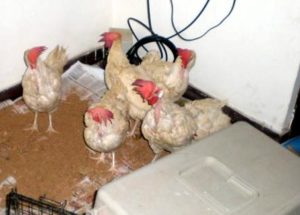 |
| The rescued chickens day 1: Hens, scared and sick |
Observations also indicate that chickens bond with one another, protect each other, and have empathy for the other. Himani, a vegan friend from Mumbai who was involved in the rescue of six battered egg-laying hens while she was working at PETA, testifies this. Out of the six hens, one was especially weak. Himani observes on day two of the rescue:
“One hen would still barely come out of it…. when we would enter the room, they would all huddle around that one protectively. To the extent that there were times we could only see five of them, and we would get worried about the sixth. They would surround her and screech at us defiantly to keep us from coming closer. We figured she must be very sick and that the others were trying to protect her at all times.”
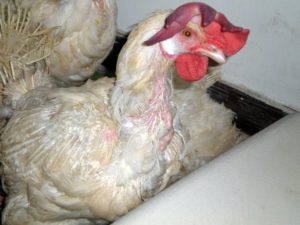 |
| The rescued chickens day 2: Swellings and rashes |
The mystery of the “sick” hen is solved on day four of the rescue, as Himani observes:
“This morning when I entered the room there was a surprise. We found an egg in one of the cages! And the sick bird sitting with it while another one hovered around the entrance of the box protectively. We were just not prepared for this, and were relieved to realize that this was the reason the other birds were behaving so strangely. Somehow, seeing the egg made the whole event so much more personal. She was going to die while she had an egg developing in her womb, it was a disquieting moment for all of us.”
Every day, millions of chickens helplessly watch as their counterparts are killed in full view of each other. They are unable to protect one another causing them much fear and stress.
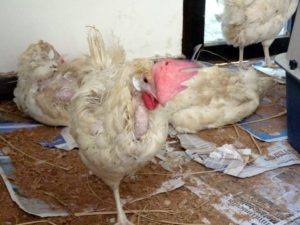 |
| The rescued chickens day 3: Walking around, eating |
Speaking of motherly and fatherly care and protection, mother hens protect their young ones from predators with the help of their wings – frantically flapping them to scare off the source of the danger or tenderly spreading them out to bring comfort and safety to their chicks. The roosters too have a role in bringing up young ones as they sit guard over the flock and alert the hens if they sense danger. Plutarch, who was deeply influenced by Pythagoras’ view of non-violence towards animals, writes this about the hens:
“What of the hens whom we observe each day at home, with what care and assiduity they govern and guard their chicks? Some let down their wings for the chicks to come under; others arch their backs for them to climb upon; there is no part of their bodies with which they do not wish to cherish their chicks if they can, nor do they do this without a joy and alacrity which they seem to exhibit by the sound of their voices.”
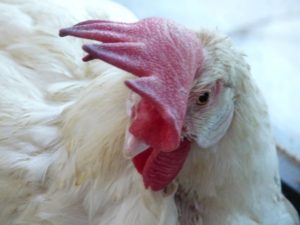 |
| The rescued chickens day 4: Looking better…. |
Not only their own species, chickens are also affectionate towards humans. They form bonds with humans if they are talked to by making direct eye contact. Dr. Karan Davis, in her essay, The Social Life of Chickens, writes:
“Chickens represented by the poultry industry as incapable of friendship with humans have rested in my lap with their eyes closed as peacefully as sleeping babies, and as I have noted, they quickly learn their names. A little white hen from the egg industry named Karla became so friendly, all I had to do was call out “Karla!” and she would break through the other hens and head straight toward me, knowing she’d be scooped off the ground and kissed on her sweet face and over her closed eyes.”
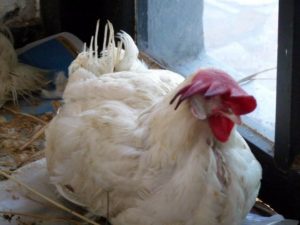 |
| The rescued chickens day 4: ….and fluffy with a little care |
Chickens also have memory; they miss the absence of their counterparts. They update their memory too. According to research, they can remember more than a 100 other chickens and recognize them. In the same essay, The Social Life of Chickens, Dr. Karan Davis writes:
“I’ve watched many a returning hen be greeted by her own flock members led by the rooster walking over and gathering around her conversably, as if they were saying to her, “Where have you been?” and “How are you?” and “We’re glad you’re back.””
(This essay is being published this year as a chapter in the forthcoming book, Experiencing Animals: Encounters Between Animal and Human Minds published by Columbia University Press.)
Chickens not only have personalities as a subspecies of the Red Jungle Fowl of South East Asian forests that they are, each chicken has a distinct personality and unique ways of expressing themselves. Observations pouring in from the many people who have rescued or lived with chickens highlight the fact that no two chickens are alike in their response to the same stimuli. We especially quote once more from Himani’s account, which shows that even in coming out of a traumatic past, each of the six egg-laying hens had a distinct manner of adjusting and expressing themselves while making sense of the new world – a world quite the opposite of the cruelty they had known until that point.
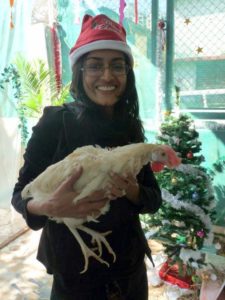 |
| Himani: Santa for the rescued hens |
Himani, recounting day four and five with her rescued hens narrates:
“One would throw attitude, she would come to the door when we walked in, look us up and down and walk away in a huff like she had seen it all and it was just so boring. There were two who were forever panicking and clucking, and one who was adorably shy, she would hide behind the boxes and peep out from there. The remaining two were simply funny and had to investigate everything they could get to.
Of my favorites, Ms. Curiosity 1 [Ms. C1] was a tough cookie. After having endured all the pain of being in a cage for two years, being dragged around by her legs and being thrown for dead by people, this spunky bird was still keen on figuring everything out. Since the third day itself, when all the other birds were still terrified of us, she would try to come close to me. Looking duly uninterested of course, she would pretend to peck food and slowly walk toward me. The slightest movement from me would cause her to panic and run back to the safety of her group, but then in a few minutes she would be back.
[Day five, the day of the first outing] When I entered the room, my friend Ms. C1 came up to me to greet me quite confidently, and when I opened the door to the garden she was the first to step out. She went out inspected everything, came back to the room and crowed loudly. The others then slowly started taking the chance of stepping out. They were in natural sunlight and space for the first time in their lives. Most of them just froze with uncertainty…. some went right back in. Two stayed out and started exploring the area. The sick hen also started to hesitatingly come out and had taken to hiding behind me when she felt threatened…. Some would just take a few steps in, some would walk all around and peck away at the feed bowls of the cats. Ms. C1 would actually go from table to table, check each person out from head to toe…. then walk away making clucking sounds.”
To read Himani’s full account of the rescue, you can click the two images below.
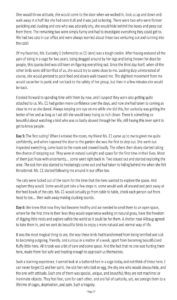 |
| Page 2 |
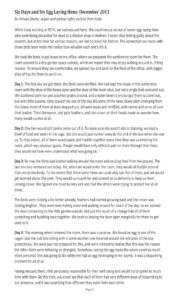 |
| Page 1 |
Six Days and Six Egg-laying Hens
(Please click the images a second time for an enlarged view.)
In his paper, Pain in Birds, Dr. Michael Gentle writes:
“Comparing pain in birds with mammals, it is clear that, with regard to anatomical, physiological, and behavioural parameters measured, there are no major differences and therefore the ethical considerations normally afforded to mammals should be extended to birds.” (p.235, source)
When asked whether poultry animals feel pain, Dr. Ian Duncan, Professor of Poultry Ethology, University of Guelph, Ontario, Canada had this to say:
“It is indisputable that poultry are capable of feeling pain. All poultry species are sentient vertebrates and all the available evidence shows that they have a very similar range of feelings as mammalian species. Poultry can suffer by feeling pain, fear and stress.” (source)
Chickens have pain receptors, thermo-receptors, and physical-impact receptors very similar to us that cause them to feel distress of all kinds. Dr. Gentle who performed the “comb pinch test” on chickens report them to show “active avoidance behavior…. and vigorous escape attempts involving jumping, wing flapping, and occasionally calling.” (source). Chickens raised for their flesh and eggs have their beaks and feathers full of sensory nerves severed with hot blades to prevent them from pecking each other and flapping their wings.
Some of the normal day-to-day activities of chickens that they have evolved to perform include sunning, dust bathing, pecking, scratching, and nesting. They sunbath for general health, dust bath for the health of their feathers, peck to express myriad emotions, scratch to comb the ground for food, and nest to lay eggs. These activities are severely impeded when chickens are confined within cages. Inside cages they live lives just as humans implicated for crimes in dank prison cells do, except that they have committed no crime.
Their beaks, which are just like our hands and contain a high concentration of sensory receptors, are mutilated to prevent them from pecking each other. Without any space to move within the crammed cages, that is the only way they can put their pecking instinct to use. They are never able to use their wings that were meant to be flapped. An egg-laying chicken that was meant to live for at least 7-20 years (source) withers at two, while the lives of chickens for meat are abruptly cut short as soon as they gain full plume, which is around six weeks.
If Nature meant for us to eat them and use them as egg-producing machines, why should their natural life span be so much more longer?
Most of us know how our fruits, vegetables, and grains are produced. The fields and the orchards are open for us to see and visit. However, it is not the same with the animal products industry. You only see the end product that the manufacturer wants to sell to you – attractively packaged with pictures of “happy” animals and with the goat and sheep disguised as “mutton”, the pig disguised as “pork”, the cow disguised as “beef”. But the poor chicken, the most abused animal on Earth today, is thought nothing of, the advertisers don’t even feel the need to disguise them – they are simply called the “chicken” after the name of their species while demand is created for their body parts in terms of “fried chicken wings”, “succulent chicken legs”, “tender chicken breasts”, and so on.
~The broiler chicken
The “broiler chicken”, a concept from the West, has gained credence in India backed by huge advertising budgets. The ads. sell death with the promise of health and taste, and the tragedy is many of us buy in.
For some facts, broiler chickens are actually baby chickens exclusively raised for meat in very controlled (read unnatural) environments. The muscle tissues of their breasts and thighs are genetically manipulated to yield more “meat”. With the growth hormones that they are fed, the birds become so “breast-heavy” that they cannot stand on their two legs. To prevent them from dying since their heart and lungs cannot support their body weight, they are fed antibiotics. The birds in the broiler farms suffer from lameness, gastrointestinal and blood diseases, and chronic respiratory infections (source).
Michael Specter, writer of New Yorker, on his first visit to a chicken farm in April 14, 2003 writes:
“I was almost knocked to the ground by the overpowering smell of feces and ammonia. My eyes burned and so did my lungs, and I could neither see nor breathe…. There must have been thirty thousand chickens sitting silently on the floor in front of me. They didn’t move, didn’t cluck. They were almost like statues of chickens, living in nearly total darkness, and they would spend every minute of their six-week lives that way.” (source)
As Mr. Specter had experienced on his first visit to a chicken farm lasting a few minutes, the atmosphere in the dark warehouses where the chickens are housed is poisoned with ammonia fumes. As a result, many chickens are afflicted by a blinding disease called ammonia burn. In these filthy warehouses ridden by many infections and with no space to move, the chicken’s cognitive and emotional capabilities are severed by breaking every connection that the bird’s body has to feel and make sense of the external environment. No wonder that they sit in darkness “like statues”; they could be thinking a hundred different things, shall we ever know.
The chickens are typically kept in the warehouse in these conditions for 35-45 days after which they are sent to be killed at your neighborhood chicken shops as “fresh” chicken or killed with state-of-the-art technology (read death machines) to be converted into pre-packed nuggets, salami, sausages, and so on. FreeBetty.com, a website devoted to raising awareness about chicken suffering writes about the first and last journey of the broiler chicken. These and other methods employed to use and eventually kill the chicken will often be termed as “industry best practices”:
“The broiler chicken’s first glimpse of the outside world will be as she is trucked for slaughter. Her last glimpse of the world will be hanging upside down with her feet shackled in metal stirrups attached to a moving conveyor belt. Her head will be drawn through an electrified water bath to stun her unconscious before an automatic knife cuts her throat. Some birds are not so ‘lucky’. Those who raise their heads and miss the electrified water bath face the throat cutting machine fully conscious.” (source)
Virgil Butler, a former chicken slaughterhouse worker in Grannis, Arkansas testifies the final moments.
“The chickens hang there (on the conveyer belts moving towards the killing knife) and look at you while they are bleeding. They try to hide their head from you by sticking it under the wing of the chicken next to them on the slaughter line. You can tell by them looking at you, they’re scared to death.” (source)
And, as we started out saying at the beginning of this section, these atrocities are no longer a “western country phenomenon”. They are happening right here in our country because of our uninformed and misinformed choices, and our general apathy.
~The egg-laying chicken
Research in trans-species psychology has shown that the egg-laying activity is an “extremely important and private part of a chicken’s life”. Under normal circumstances, as the hens prepare the eggs, the roosters guard them and bring them food from time to time. However, in the commercial egg industry nothing remotely of this sort happens.
The egg-laying hens are crammed in small cages with several of them together for around two years. Their hand-like beaks are severed so that they cannot peck each other out of frustration. There they sit in their own feces or feces that fall on their heads from the cages above, subjected to ejecting eggs one after the other – many more than they would have under natural circumstances and in an utterly disrespectful manner. Observations have revealed that hens lay eggs in private and forcing them to lay eggs under the conditions described above goes against their dignity. It is just like how human dignity will be compromised if they were forced to defecate in front of one another (ethologist Konrad Lorenz).
If your egg producer tells you that your eggs are “free-range” or “cage-free”, it simply means that the chickens are not crammed in cages but are instead crammed in closed warehouses with cemented floor and less than a square foot of space for each. All these conditions, whether free-range or not, lead them to suffer from uterine prolapse and osteoporosis and this in turn leads to a slow, painful death (source). Again, whether free-range or not, the only time these hens ever breathe fresh air is when they are loaded to be transported for slaughter following decline in egg production.
In this entire process of laying eggs, there are no roosters to guard the to-be-mother hens and bring them food. Instead, the hens are starved so that the industry can manipulate the eggs and market prices (source).
The male chicks are unwanted byproducts of the egg industry as they have no commercial value. Unwanted, so they are killed almost immediately after they peep out from their mother’s eggs. The sex of the chicks are sorted on a conveyer belt and the males are tossed into gas chambers (source). In some other facilities, they may also be electrocuted, crushed alive, or simply thrown into trashcans to slowly suffocate to death (source).
If Nature meant the chicks to experience the warmth of their mother’s wings as soon as they are born, what is happening here?
A part of the human race had experienced something similar decades ago in the concentrations camps of the Second World War. Upon arrival at the camps, they had been sorted into different categories of convenience; infant children had been taken away from the arms of their mothers to be gassed separately.
According to the ancient spiritual texts of our land, a human being takes on the karma of the animal they eat. This resonates with the famous saying, “you are what you eat”. This does not mean we start looking like an abused chicken, grow mutilated beaks and clipped wings if we eat them, it simply means that in eating chickens we assimilate their pain, misery, and suffering within our own bodies. Their flesh and eggs containing cellular memories of the agonies of de-beaking; confinement; being tramped, gassed, crushed; bereavement…. are absorbed within us. Their eggs and flesh contains all the stress and fear hormones released by the dying birds. How these hormones adversely affect us physically besides negatively influencing our stock load of karmas, forms a well-documented body of medical research today. At the broadest level, the same sentiment had been articulated by genius Mathematician, Pythagoras two thousand years ago in ancient Greece. He had said, “For as long as men massacre animals, they will kill each other. Indeed, he who sows the seed of murder and pain cannot reap joy and love”.
While many people in the world today have stopped eating chickens and their eggs for spiritual and ethical reasons, many have done so for health reasons. But that is not enough. Chickens continue to be the most mistreated and disrespected among the birds at this point of time on this Earth, abused by us – the self-conferred “most intelligent” species on Earth. How intelligent are we if we are unable to empathize with another sentient being? Do we not want to empathize with the chicken because if we do, it will conflict with our interests of what we want to do with them? Deep down, do we fear that empathizing will stop us from maltreating them?
Dr. Will Tuttle, the author of the bestseller, World Peace Diet, shares a profound message in our conversation with him on this space:
“I would encourage you not to be seduced by the mechanistic immaturity of the West, and especially not to adopt the cruel food practices of the West. I would encourage you to remember your glorious heritage of compassion and cooperation, to remember Asoka and other enlightened examples of kindness for all, and to strive to live the teaching of ahimsa and continue to make India the light of sanity and harmony in the world.”
We rest our case and end the story with a final quote from Charles Darwin whose work in evolutionary biology has inspired many trans-species psychologists in the modern age:
“There is no fundamental difference between man and the higher animals in their mental faculties…. The lower animals, like man, manifestly feel pleasure and pain, happiness, and misery.”
Acknowledgements
This blog is grateful to:
- ~Dr. Karen Davis, President of United Poultry Concerns (UPC), for sharing her invaluable inputs for this story and permitting us to use content from the UPC website.
- ~Himani Shetty, vegan, animal rights activist from India, for sharing her stunning account of the rescue of six egg-laying hens. Himani received the Vegan of the Year – 2012 award by Indian Vegan Society.
- ~Surya Ranjan Shandil, high-end software technology developer and, hobby painter and graphic artiste from India, for his sensitive portrait of the chicken.
- ~All the scientists working in the field of trans-species psychology for caring to study and make inferences about the cognitive capacities and emotional lives of animals.
References
Compassion Over Killing
Free Betty (link expired)
Friends of Animals (link expired)
United Poultry Concerns
Recommended books
Prisioned Chickens, Poisoned Eggs by Karen Davis
The Development of Brain and Behaviour in the Chicken by Lesley J. Rogers
The Holocaust and the Henmaids’ Tale by Karen Davis
You can also read an essay profiling the goat in this blog post, Of the Goat: Gentle and Trusting.
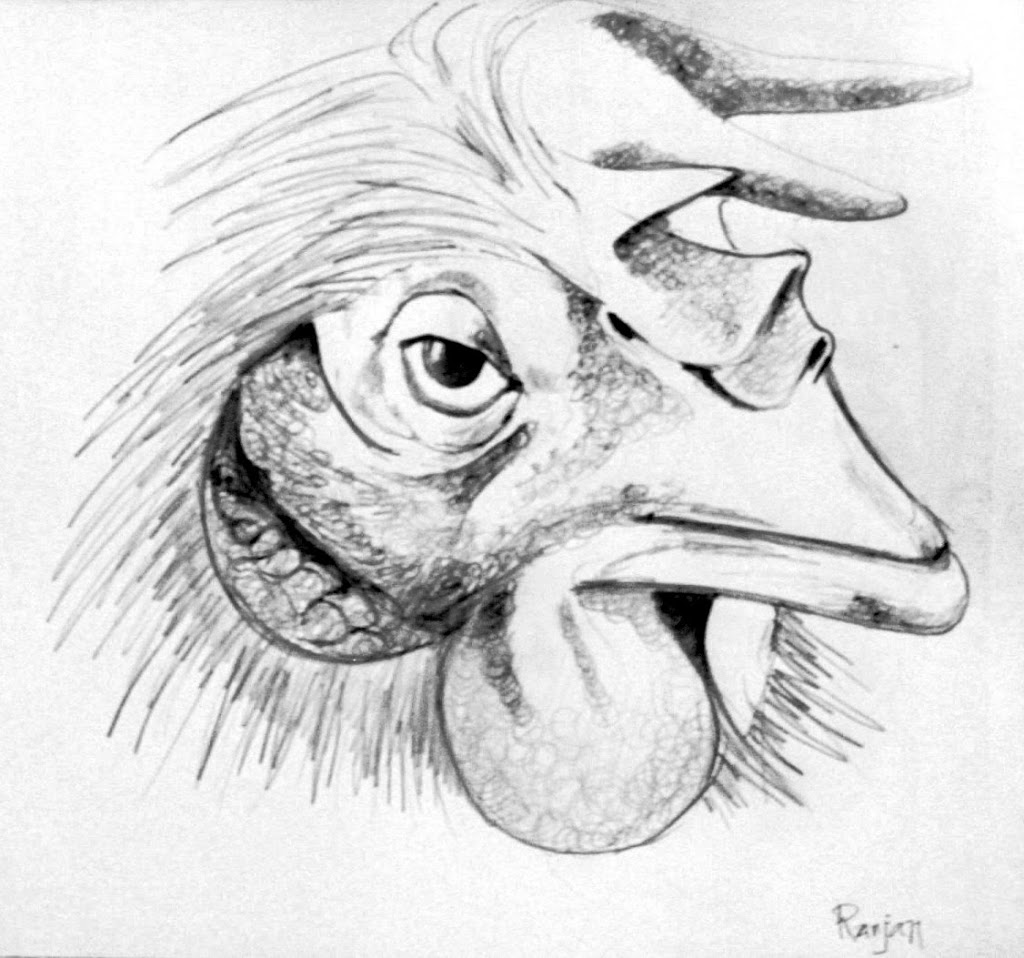
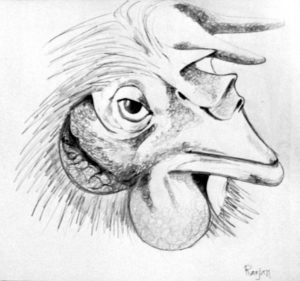
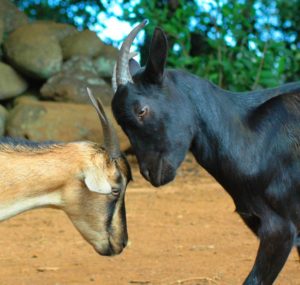


Pingback: In Conversation with Dr. Karen Davis: Of Practical Applications of Trans-species Psychology, Of Demystifying Anthropomorphism, and Of The Holocaust and the Henmaid’s Tale - Vegan India!
Pingback: Of the Goat: Gentle and Trusting - Vegan India!
Thank you Dr. KV Rangan for your observations. We have been able to present only a fraction from the documentation that exists on the emotional lives and cognitive capacities of chickens. In fact, they are so similar to dogs and cats many of us have as cherished companions. Thank you for mentioning the recent Cambridge Declaration signed by scientists from all over the world acknowledging that animals are conscious beings just like us humans. We can't but agree with you more that this declaration can be used as an effective tool for animal rights activism.
Once again your hard work and passion for veganism is evident in this well researched and detailed article. Just two days back I saw a resolution by a group of scientists in Cambridge that animals have similar consciousness as humans. This is indeed overwhelming because it gets tremendous credibility when it comes from the scientific community, although we have known all this intuitively for ages.
I read with interest the many facts you have presented about chickens-their ability to do a certain amount of logical reasoning, ability to remember, evolved social behavior, family bonding and even empathy towards fellow beings. The endorsements by so many scientists prove the abilities of the chickens without any shadow of doubt.
I visited the UPC website and watched with interest the video presented there. I came to know of their rescue operations and awareness campaigns. It was a great relief to see the chickens roaming freely and peacefully.
The account by Himani Vegan made a very interesting reading. She has beautifully narrated how each of the chickens they rescued had a distinct personality. I am Happy to learn that they have now found a safe home.
Congratulations to Vegan India team for posting such an insightful, detailed and informative article about the chickens. It rends the heart when we see these birds transported like dirt in vans, scooters and motorcycles, often hung upside down without any sense of remorse whatsoever. When will this darkness end
Thank you Dr. Davis for your comment. It was very important for us to explore deeper our kinship with animals and this collaboration with you made it possible. As vegans, we all intuitively know that animals have consciousness just like us; however, it was wonderful to research why we instinctively form these unsaid bonds with animals just like how we would with members of our own species — because animals are so much like us! Our socialization does little to nurture these bonds in early childhood, even goes to the extent of severing them, so that we are never able to explore our kinship with animals. Thank you once again, the heart feels very heavy seeing how our fellow Earthians suffer, we are united with you in the experience of this suffering. "May all that have life, be delivered from suffering". The Buddha
Thank you for your wonderful, inspiring and informative website educating people about the beauty, dignity and abuse of chickens. I am very proud and grateful to Vegan India! for the opportunity to contribute. I've been rescuing and caring for chickens for 27 years, and my love for them grows as does my sorrow over how terribly they suffer at human hands. Vegan India! will teach many people the truth about chickens and why a compassionate vegan diet and way of life is the truest gesture of world peace that one can make. Thank you and best wishes on behalf of chickens everywhere!
Karen Davis, PhD, President, United Poultry Concerns. "Don't just switch from beef to chicken. Get the slaughterhouse out of your kitchen. Go vegan!" http://www.upc-online.org/recipes/